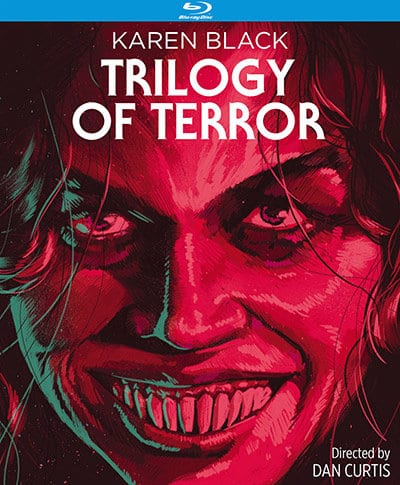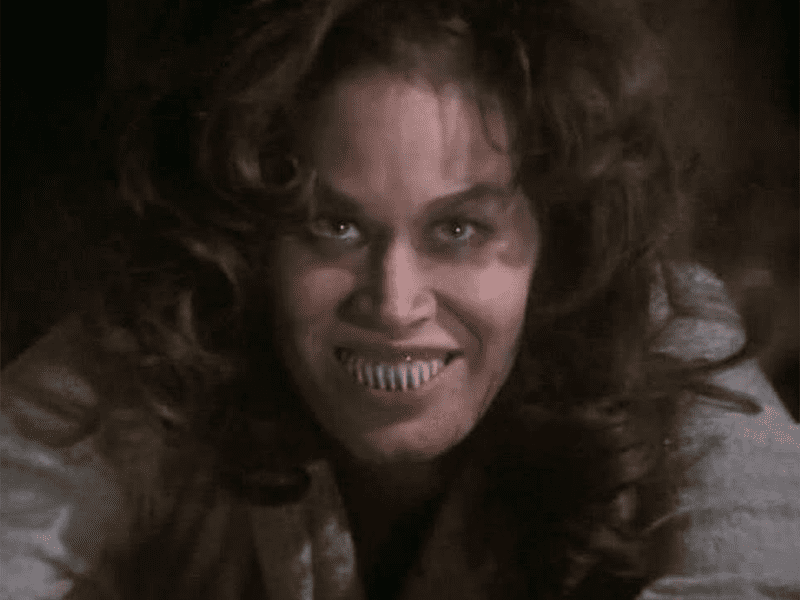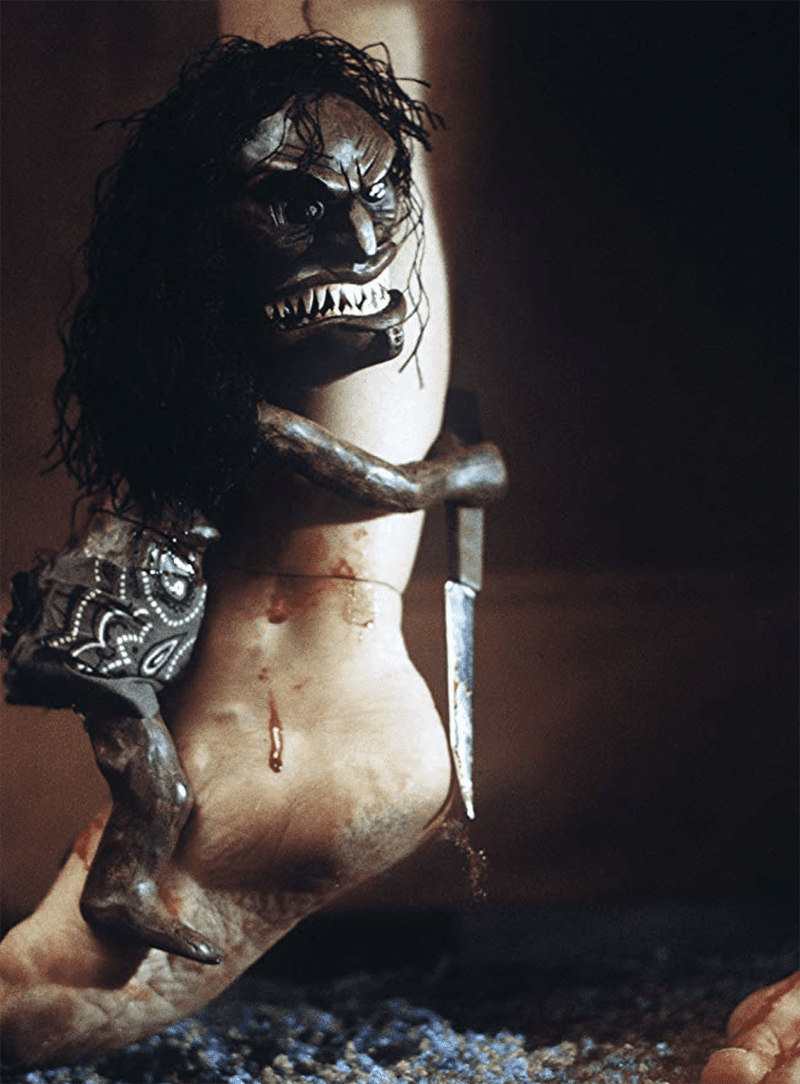
They don’t always remember the name of it, but just about everyone who was conscious in front of an American TV in 1975 seems to be have been scarred by that little Zuni doll in Trilogy of Terror. One of the most well-remembered chillers of its day, the TV movie is now freshly remastered on Blu-ray from Kino Lorber, along with two other celebrated and influential TV horrors from the same producer and the same writer.
The producer is Dan Curtis, who came to prominence by masterminding the cult soap opera Dark Shadows. In the character of Barnabas Collins, that series more or less invented the romantic self-hating vampire who yearns to be good and seeks a cure, setting hearts aflutter along the way. Tim Burton’s 2012 film with Johnny Depp was the latest of several incarnations for this property. Curtis parlayed his soapy success into a series of handsome TV movies based on classic novels, including 1973 versions of Dracula, Frankenstein and The Picture of Dorian Gray and a 1974 Turn of the Screw. He was all about horror with gothic class.
The writer is Richard Matheson, one of the 20th Century’s most celebrated and successful creators of the fantastic. If this giant of the genre had a recurring theme, it’s romantic frustration and the crisis of postwar masculinity. His classic short novel, The Shrinking Man, literalizes a fear of man’s reduced economic and sexual stature as shrinkage renders its hero impotent to fulfill his traditional role as breadwinner or husband. That book was turned into an excellent film, while there have been at least three films (none done properly) of his novel I Am Legend. Its hero spends most of it mourning his wife, blaming himself for her death, and feeling sexually frustrated.
Matheson’s many scripts for The Twilight Zone include “Nightmare at 20,000 Feet”, based on one of his stories, about a man whose heroism is indistinguishable from madness. My favorite episode, if it isn’t that one, is Matheson’s “Steel”, again based on his own story, an unflinching portrait of a washed-up loser bereft of all options except to get himself pounded by robots in the boxing ring. By no coincidence, Matheson scripted Steven Spielberg’s seminal TV movie DuelDuel (1971), again based on his own story, which is another tale of an ordinary man symbolically pitted against the machine age and another cathartic exercise in menace and suspense.
Matheson was on a roll in TV movies, for he moved on to The Night Stalker (1972), which promptly became the highest rated TV movie to date and required a sequel, The Night Strangler (1973), both starring Darren McGavin and both produced by Curtis. John Llewellyn Moxey directed the first and Curtis himself did the second. These are the other two Blu-rays released along with Trilogy of Terror, and we’re not discussing them here. For the moment, we’ll just say they’re excellent combinations of humorous characterizations and hair-raising monster-hunting, as put over by McGavin’s wry and rumpled anti-heroic persona, and the resulting short-lived series, Kolchak: The Night Stalker, cast a long shadow through its influence on Chris Carter’s The X-Files.
Matheson’s other Curtis projects were the aforementioned Dracula and Scream of the Wolf (both 1974), then Trilogy of Terror and another anthology film, Dead of Night (1977). We’d be remiss not to mention his uncannily claustrophobic script for Philip Leacock’s Dying Room Only (1973), a thriller starring Cloris Leachman (and, like Duel, essentially plunking its hapless hero in the desert), and Michael Anderson’s three-part mini-series of Ray Bradbury’s The Martian Chronicles (1980), which stars McGavin in a major role. Bradbury and Matheson were good friends who’d both written for Alfred Hitchcock Presents and The Twilight Zone. How cozy it all must have been.
On the big screen, this era saw Matheson scripting two films from his own novels: John Hough’s The Legend of Hell House (1973) and Matheson’s personal favorite of all films based on his work: Jeannot Szwarc’s Somewhere in Time (1980), another tale of aching romantic non-fulfillment in which the hero botches it and feels alienated from his own era. Matheson consistently comes across as a romantic moralist who doesn’t believe in happy endings but does believe in radical isolation. His heroes are fate’s victims and their only recourse is to accept their destiny.
As some of these plots indicate, sexual politics is often a submerged context, and sometimes not so submerged. This point brings us squarely to Trilogy of Terror, an anthology showcase for Karen Black. The traditional line on this project is that the first two stories are okay and the third is the masterpiece, and while we won’t take serious issue with that, we must observe that the first two are harsher and more interesting than that summary implies, and all resonate with each other more tellingly than in most anthologies.
Black plays four characters, more or less, in the three tales, as all explore themes of possession and multiple identities. Another theme common to all three is sexual trauma, and that theme is pushed as far as network TV was prepared to go in 1975. The result is that they still play uncomfortably today.
“Julie” opens with two male college students radiating privilege and evaluating the skirted passers-by. When mousy Miss Eldridge, or Julie (Karen Black), passes in her glasses and dull brown tweed ensemble, hugging her books to her chest, Chad (Robert Burton, Black’s husband at the time) suddenly wonders aloud what she looks like under her clothes.
She’s his English teacher, and their dialogue on rape scenes in Faulkner and Fitzgerald proves more than academic as his visions of her inflame his imagination and lead him to invite her to a drive-in for a French vampire movie (actually footage from The Night Stalker). He gives her what we’d now call a “rufie” and takes her to a motel. With compromising photos, he blackmails her into continuing a demeaning and abusive relationship by pointing out that, as the teacher, she has more to lose in their inappropriate relations.
At least that’s a superficial reading of what’s happening. The fact that Eldridge sounds like “eldritch” may clue the cannier viewers into where this is going, and the resulting hornets’ nest of ambiguities creates a Rorschach blot for the viewers’ ideas of empowerment and control.
Today’s viewers will have even less trouble anticipating the conclusion of “Millicent and Therese”, in which Black plays an uptight black-clad Millicent (glasses again) and her lipsticked, swinging twin Therese, denounced by Millicent in her diaries and conversations as evil. Their father’s recent death has brought things to the current crisis.
The story doesn’t spell this out bluntly, but one implication is that personality disorders may be the product of sexual trauma within the family. Shirley Jackson explored this idea in her novel The Bird’s Nest, filmed as Hugo Haas’ Lizzie (1957). Such a pathology explains why Millicent claims the evil began at 16, when Therese seduced their father, soon after which mom committed suicide. Millicent’s blame of Therese functions as internalized hatred, with Millicent acting as superego to her sister’s libido, but we must resist giving away the “surprise”.
These stories play with fire and do what tales of horror and the macabre are supposed to: transmute real social fears into metaphorical charades for our unsettling entertainment so we don’t know which end is up. These first two sections, while based on Matheson stories, are scripted by his fellow writer and Twilight Zone alumnus William F. Nolan. He too was having a great decade, scripting Turn of the Screw for Curtis and having his novel Logan’s Run turned into a movie and TV series.
The third tale, “Amelia”, scripted by Matheson himself from his story “Prey”, burned itself into many an impressionable young cerebrum. The story is a one-woman show taking place entirely in her high-rise apartment, and it justifies the title’s promise of terror. The premise sounds foolish: our heroine brings home a small “Zuni fetish doll”, complete with spear and sharp white teeth and awful hair, that chases her through a vicious pell-mell life-or-death struggle. It’s funny and absurd and genuinely nerve-wracking in its pains and triumphs. That’s partly because, as Black observes, it’s the little things you should be able to control that get out of hand and turn deadly.
The magic’s in the execution, from a graceful unbroken shot of over three minutes as Amelia enacts a fraught phone call with her mother, to the rapidly edited, darkly lit, dutch-angled nightmare, with its accordion pacing and alternations of silence and unnerving noise. Curtis’ tendency to shoot from low angles arrives at its logical conclusion during the moments of frantic subjective Zuni-vision speeding across the carpet, a visual trope we’ve seen many times since.
Another reason it works so well is that Amelia is efficiently established as a woman who, while trying to be independent for the first time, feels torn between her domineering mother and her demanding boyfriend — it’s the superego/libido split again, and the holistic personality gets shredded in the middle.
“Not even your mother could love you”, says Amelia with unconscious irony, immediately identifying herself with the “ugly” doll and yes, it’s something about the hair. As she simultaneously talks to the doll and to herself, for it’s the same thing, the fetish manifests her self-destructive impulses, her desire to squash her own ineffective ego. She wants to give the doll to her boyfriend, but perhaps she buys it unwittingly as a signal of her own desire to be a warrior. She puts it on the table before girding her loins to call her mother (“Let’s get it over with”), and the doll hears, sees, understands, and takes action with none of her waffling and shilly-shally.
This is a more productive reading than the vague xenophobia of this intrusion from another culture. American Indian? African? Maori? Richard Harland Smith runs through the possibilities in his commentary. In his interview, Matheson seems to think Zunis are Africans, but this generic Otherness is beside the tale’s psychological point, which is to evoke our “primitive” or primal impulses in the modern city as muted traffic sounds bleed into the ambience. Or to employ one of our trendiest contemporary fetishes and shibboleths, we might say that “cultural appropriation” or “tourism” turns out to have teeth for biting back.
The trilogy works as a whole because its contrasts complement its consistencies, thanks to Black and the writers, and because producer-director Curtis is good at his job. As a producer, he brought the right talent together. Dotted in the cast are veteran character player George Gaynes; Gregory Harrison, who would soon star in the Logan’s Run TV series; and Dark Shadows alumni John Karlen and James Storm. The former, misspelled in the credits, plays a Mr. Anmar, although sources for some reason called him Amman. As a director, Curtis’ visual approach is effective without intrusion, encouraging photographer Paul Lohmann’s subtly expressive movements and lighting while giving Black the freedom to explore. He would direct her again in the Nolan-scripted Burnt Offerings (1976).
Smith’s commentary discusses fascinating differences between Matheson’s original stories and these adaptations. He also draws a connection with Matheson’s Twilight Zone episode “The Invaders”, in which Agnes Moorehead delivers a bravura non-speaking performance as a farm woman attacked by little men. Of course he also discusses the sexual politics, arguing that Miss Eldridge brings out latent fantasies in the student (whom she then condemns as unimaginative and boring). He also asserts that there was never a time when everyone didn’t see the ending of the second story coming, and indeed there’s a clue in the home movie footage that opens the story. By contrast, Nolan’s commentary with Black, as retained from a previous DVD, expresses surprise that anyone could guess it, bless his heart.
Black reveals that she rewrote her phone monologue in the third story to strengthen her character’s conflict and sympathy, and she also came up with the final visual, and Matheson’s interview admits that he didn’t think that was in his script but it sure worked. She also states that they filmed more doll incidents that got cut, and this must explain why Amelia fiddles with a jammed deadbolt and why she doesn’t leave the apartment. She also states that she didn’t really want to do this TV project at a time when her film career was in full swing, but she made it a condition that her then-husband in a short-lived marriage should play the rapey student. That’s so interesting, we don’t know what to say.
The feature’s 4K restoration makes the image look richer than it has in years, and infinitely clearer than the muddy messes cluttering up a certain Tube. Composer Bob Cobert is interviewed briefly in a new extra that accompanies older interviews with Black and Matheson, both now departed.





